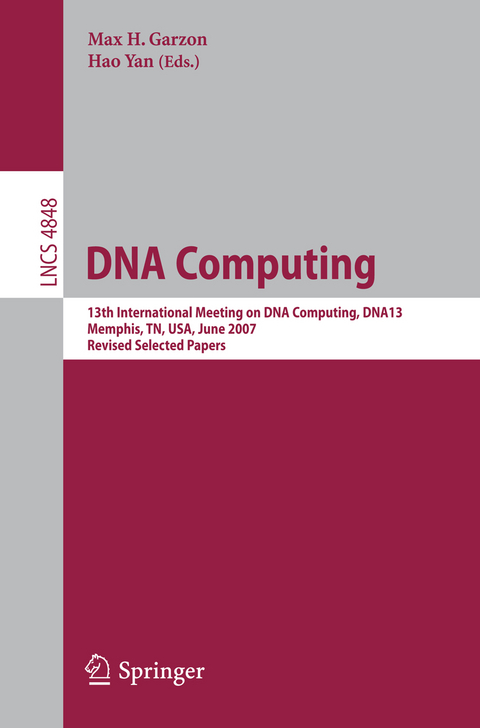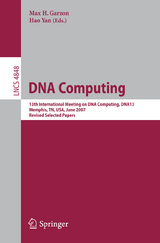DNA Computing
Springer Berlin (Verlag)
978-3-540-77961-2 (ISBN)
Biomolecular/DNA computing is now well established as an interdisciplinary field where chemistry, computer science, molecular biology, physics, and mathematics come together with the common purpose of fundamental scientific understanding of biology and chemistry and its applications. This international meeting has been the premier forum where scientists with different backgrounds and a common focus meet to present their latest results and entertain visions of the future. In this tradition, about 100 participants converged in Memphis, Tennessee to hold the 13th International Meeting on DNA Computing during June 4-8, 2007, under the auspices of the International Society for Nanoscale Science, Computation and Engineering (ISNSCE) and The University of Memphis. The call for papers encouraged submissions of original, recent, and promising experimental and theoretical results in the field. The Call for Papers elicited some 62 submissions, almost perfectly balanced among the major theoretical and experimental categories. It is evidence of how well the interdisciplinary nature of the conference has truly matured that the major criterion of quality, agreed upon in advance by the Program Committee (PC), produced a nearly balanced program as well across the two major categories, full papers and talks with an abstract only. The program with the greatest perceived impact consisted of 24 papers for plenary oral talks; in addition, 15 full-paper posters and 10 poster abstracts were accepted, of which 5 authors were invited to give five short demos in a new submission category this year. The conference program retained the structure now customary for this meeting.
Self-assembly.- Staged Self-assembly: Nanomanufacture of Arbitrary Shapes with O(1) Glues.- Activatable Tiles: Compact, Robust Programmable Assembly and Other Applications.- Constant-Size Tileset for Solving an NP-Complete Problem in Nondeterministic Linear Time.- Solutions to Computational Problems Through Gene Assembly.- Biomolecular Machines and Automata.- Toward Minimum Size Self-Assembled Counters.- A Realization of DNA Molecular Machine That Walks Autonomously by Using a Restriction Enzyme.- Autonomous Programmable Nanorobotic Devices Using DNAzymes.- Multi-fueled Approach to DNA Nano-Robotics.- Experimental Validation of the Transcription-Based Diagnostic Automata with Quantitative Control by Programmed Molecules.- DNA Memory with 16.8M Addresses.- Codes for DNA Memories and Computing.- Combining Randomness and a High-Capacity DNA Memory.- Design of Code Words for DNA Computers and Nanostructures with Consideration of Hybridization Kinetics.- Dynamic Neighborhood Searches for Thermodynamically Designing DNA Sequence.- Sequence Design Support System for 4 × 4 DNA Tiles.- DNA Codes Based on Stem Similarities Between DNA Sequences.- Novel Techniques for DNA Computing in vitro.- Heuristic Solution to a 10-City Asymmetric Traveling Salesman Problem Using Probabilistic DNA Computing.- An Approach for Using Modified Nucleotides in Aqueous DNA Computing.- Modeling Non-specific Binding in Gel-Based DNA Computers.- Stepwise Assembly of DNA Tile on Surfaces.- An Interface for a Computing Model Using Methylation to Allow Precise Population Control by Quantitative Monitoring.- Novel Techniques for DNA Computing in silico.- Hardware Acceleration for Thermodynamic Constrained DNA Code Generation.- Hardware and Software Architecture for Implementing Membrane Systems: A Case ofStudy to Transition P Systems.- Towards a Robust Biocomputing Solution of Intractable Problems.- Discrete Simulations of Biochemical Dynamics.- DNA Splicing Systems.- Models and Languages.- Asynchronous Spiking Neural P Systems: Decidability and Undecidability.- On 5??3? Sensing Watson-Crick Finite Automata.- Equivalence in Template-Guided Recombination.- Watson-Crick Conjugate and Commutative Words.- DNA Coding Using the Subword Closure Operation.
| Erscheint lt. Verlag | 8.2.2008 |
|---|---|
| Reihe/Serie | Lecture Notes in Computer Science | Theoretical Computer Science and General Issues |
| Zusatzinfo | XI, 292 p. |
| Verlagsort | Berlin |
| Sprache | englisch |
| Maße | 155 x 235 mm |
| Gewicht | 469 g |
| Themenwelt | Informatik ► Software Entwicklung ► User Interfaces (HCI) |
| Mathematik / Informatik ► Informatik ► Theorie / Studium | |
| Schlagworte | Algorithm analysis and problem complexity • algorithms • Automata • Biocomputing • Bioinformatics • bio-inspired computing • Biomolecular computing • Cellular Automata • Complexity theory • DNA Algorithms • DNA-based computing • DNA Coding • DNA Computers • DNA computing • DNA devices • DNA nanostructure • Gene Assembly • Hardcover, Softcover / Informatik, EDV/Informatik • HC/Informatik, EDV/Informatik • Modeling • molecular computing • nanotechnology • robot • Robotics • Selforganization |
| ISBN-10 | 3-540-77961-2 / 3540779612 |
| ISBN-13 | 978-3-540-77961-2 / 9783540779612 |
| Zustand | Neuware |
| Haben Sie eine Frage zum Produkt? |
aus dem Bereich




